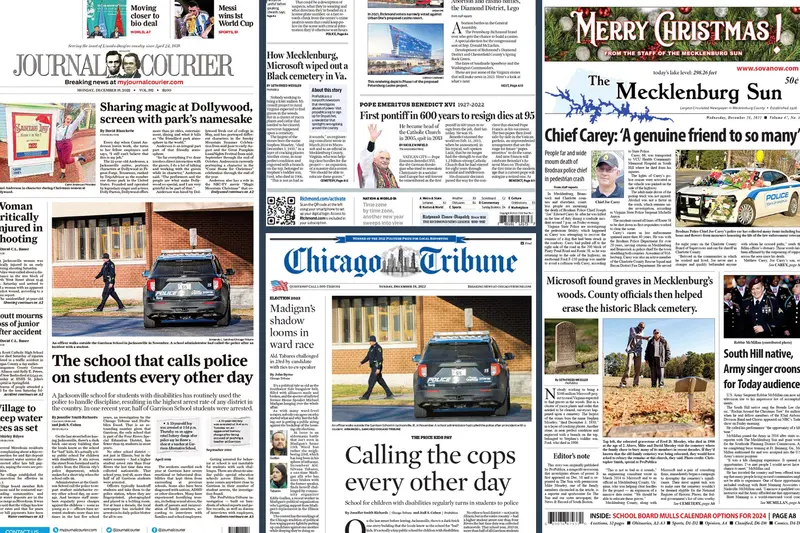The Main Principles Of News Articles
The Main Principles Of News Articles
Blog Article
Some Known Incorrect Statements About News Articles
Table of ContentsIndicators on News Articles You Should KnowThe Greatest Guide To News ArticlesRumored Buzz on News ArticlesNews Articles Things To Know Before You Get ThisExcitement About News Articles
Good understanding of different topics provides students an affordable edge over their peers. Even though digital and social networks are readily accessible, we need to not neglect exactly how vital it is to check out the papers. Parents should attempt and inculcate the habit of reading a paper as an everyday regimen to continue the heritage of the adored print tool.News tales likewise consist of a minimum of among the following essential attributes relative to the designated target market: closeness, importance, timeliness, human passion, oddity, or effect. The relevant term journalese is often made use of, normally pejoratively, to describe news-style writing. An additional is headlinese. Newspapers usually abide by an expository writing style.
Within these limits, news tales likewise intend to be detailed. Amongst the bigger and much more recognized papers, justness and balance is a major element in providing information.
Papers with an international target market, for instance, often tend to utilize a more official design of creating. News Articles.; usual design overviews include the and the US News Design Publication.
News Articles Fundamentals Explained
Generally, journalists will not make use of a long word when a brief one will do. They utilize subject-verb-object building and vibrant, active prose (see Grammar). They offer anecdotes, examples and allegories, and they seldom rely on generalizations or abstract ideas. News writers try to stay clear of making use of the same word greater than as soon as in a paragraph (sometimes called an "echo" or "word mirror").
Headings sometimes leave out the topic (e.g., "Jumps From Watercraft, Catches in Wheel") or verb (e.g., "Cat lady lucky"). A subhead (also subhed, sub-headline, subheading, subtitle, deck or dek) can be either a subservient title under the primary headline, or the heading of a subsection of the article. It is a heading that comes before the main text, or a team of paragraphs of the major message.

of a write-up topic, informant, or interviewee), it is referred to as a drawn quote or pull quote. Additional billboards of any of these kinds might show up later in the write-up (especially on succeeding pages) to tempt more analysis. Journalistic websites often make use of animation techniques to switch one billboard for another (e.g.
News Articles Can Be Fun For Anyone
Such billboards are likewise made use of as reminders to the post in various other areas of the publication or site, or as ads you can check here for the item in other magazine or websites. Press launch of the Swiss federal government. Normal structure with title, lead paragraph (summary in vibrant), other paragraphs (information) and get in touch with info.

Instance of a hard-lead paragraph NASA is suggesting another room job. The spending plan demands roughly $10 billion for the project.
The NASA announcement came as the agency asked for $10 billion of appropriations for the task. An "off-lead" is the 2nd essential front web page news of the day. The off-lead shows up either in the top left corner, or directly below the lead on the. To "hide the lead" is to start the post with background details or details of second importance to the readers, requiring them to review even more deeply into a post than they need to need to in order to find the vital factors.
Fascination About News Articles
Common usage is that a person or 2 sentences each form their very own paragraph. Journalists typically describe the organization or framework of a newspaper article as an upside down pyramid. The necessary and most intriguing components of a story are put at the beginning, with supporting information complying with in order of decreasing relevance.
It permits individuals to explore a subject to only the depth that their interest takes them, and without the charge of information or nuances that they could consider unimportant, however still making that details available to more interested viewers. The inverted pyramid structure likewise enables short articles to be cut to any type of approximate Check This Out length during format, to fit in the space readily available.
Some authors start their tales with the "1-2-3 lead", yet there are numerous kinds of lead readily available. A kicker can refer to multiple points: The last story in the news program; a "happy" story to finish the show.
Longer visite site short articles, such as publication cover short articles and the items that lead the inside areas of a newspaper, are referred to as. Attribute tales differ from straight news in numerous methods. Foremost is the lack of a straight-news lead, the majority of the moment. Rather than offering the significance of a story up front, attribute writers may attempt to lure readers in.
What Does News Articles Do?
An attribute's first paragraphs commonly connect an intriguing moment or occasion, as in an "unscientific lead". From the particulars of a person or episode, its view swiftly widens to generalities regarding the tale's topic.

The Editor's Toolbox: A Referral Guide for Beginners and Professionals (2001) Allan M. Siegal and William G. Connolly. The New York City Times Manual of Style and Use: The Official Style Guide Used by the Writers and Editors of the World's A lot of Authoritative Newspaper (2002) M. L. Stein, Susan Paterno, and R.
Report this page